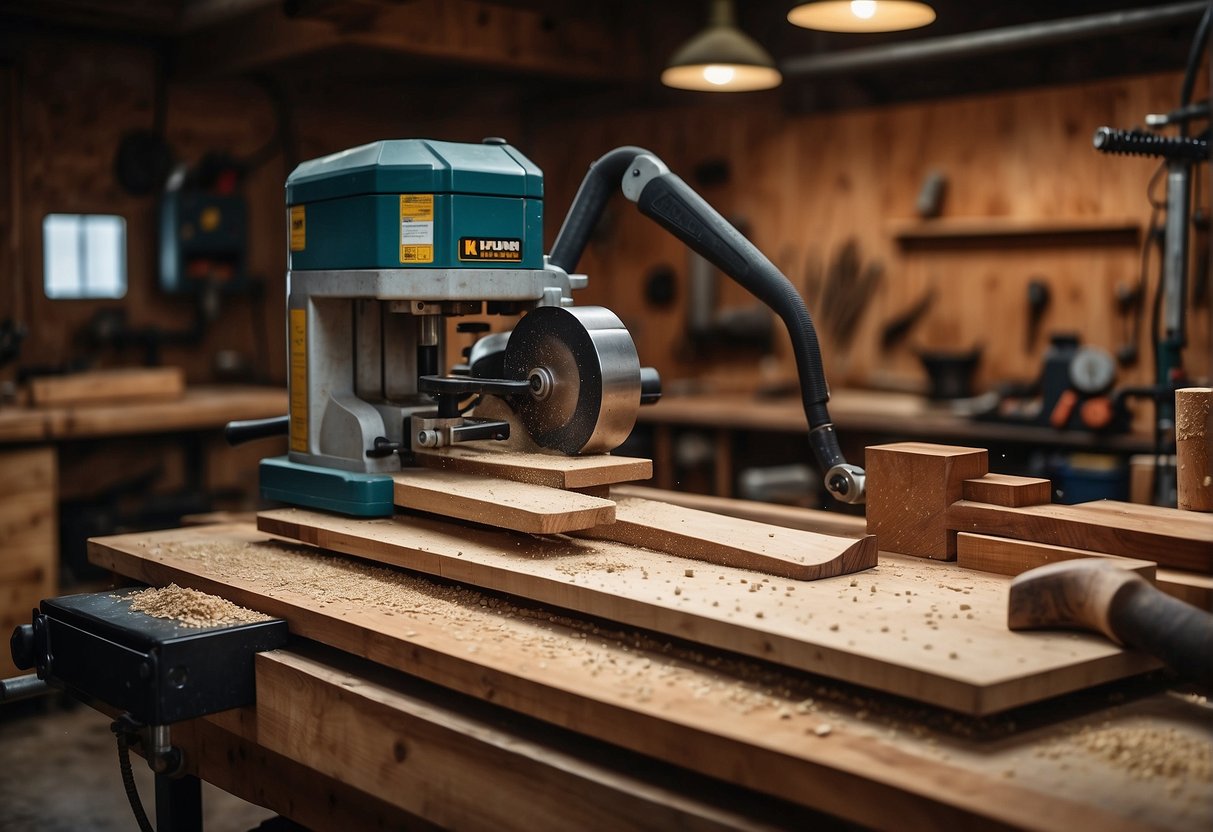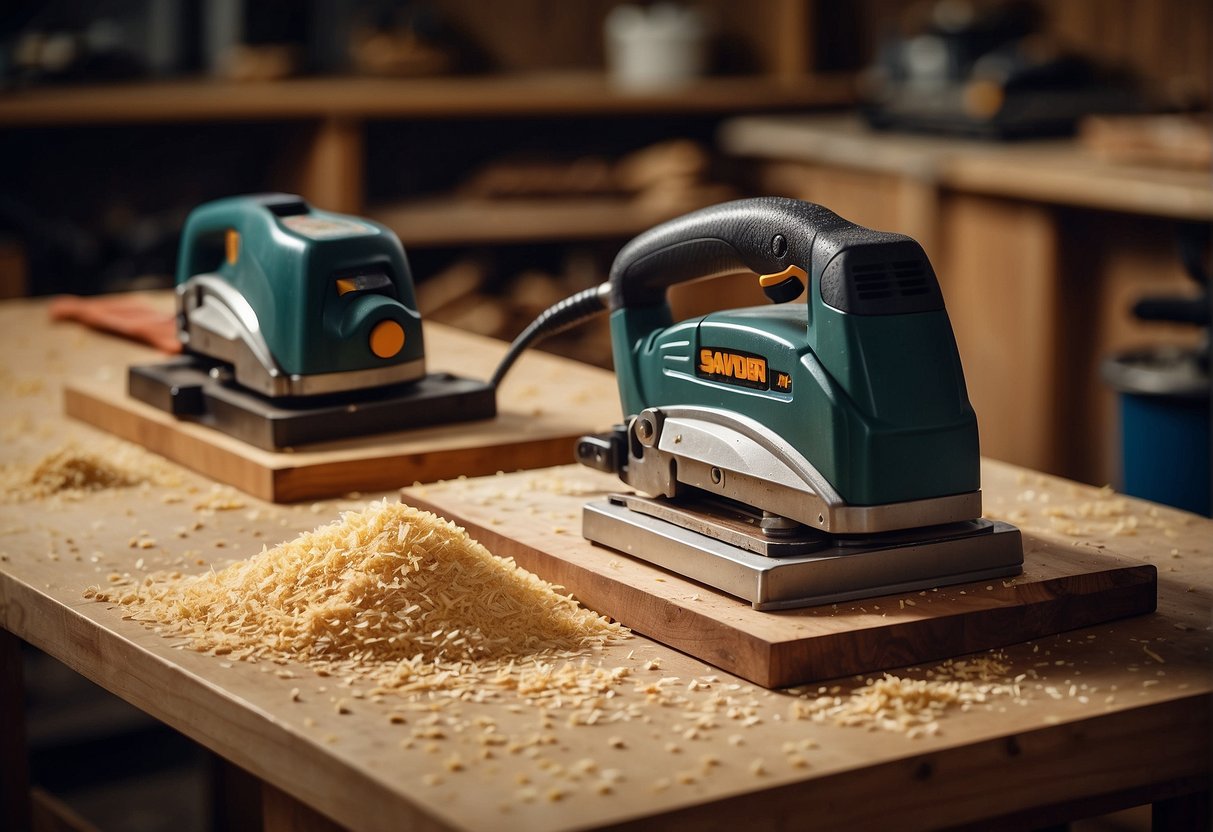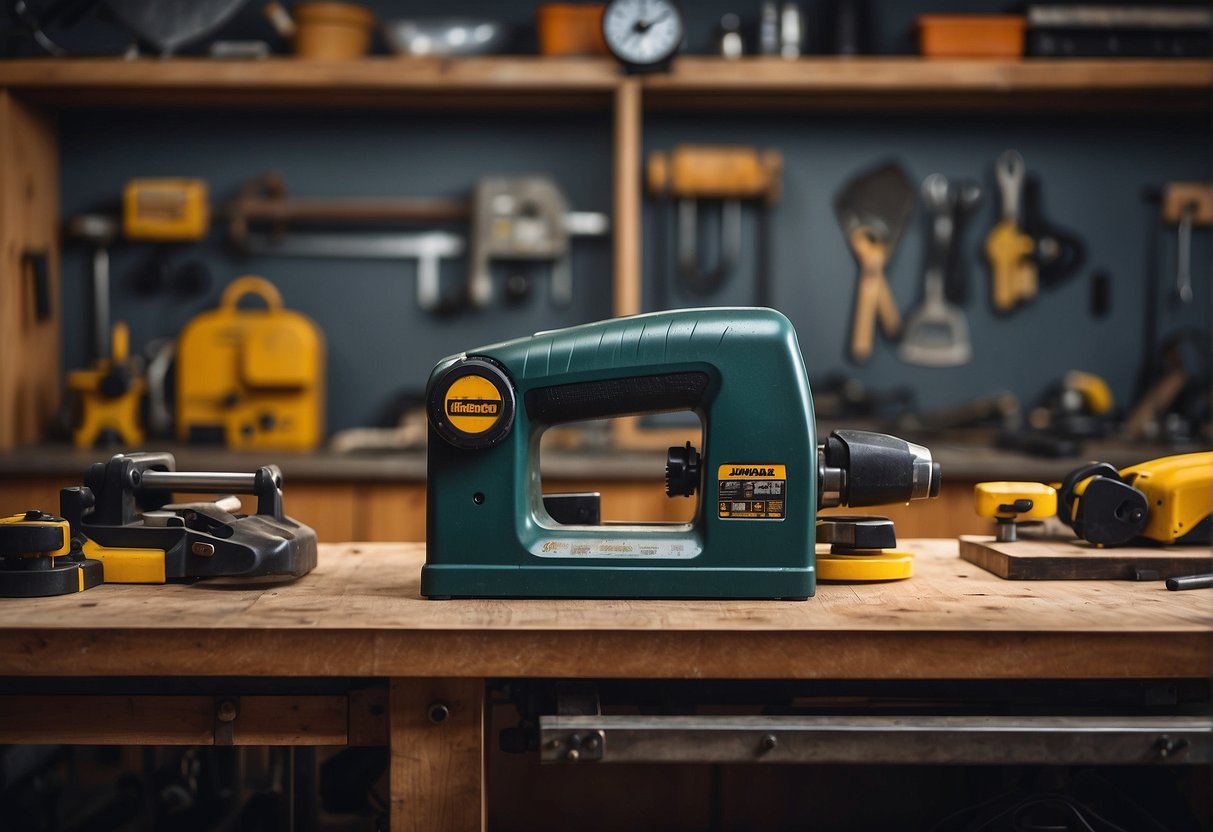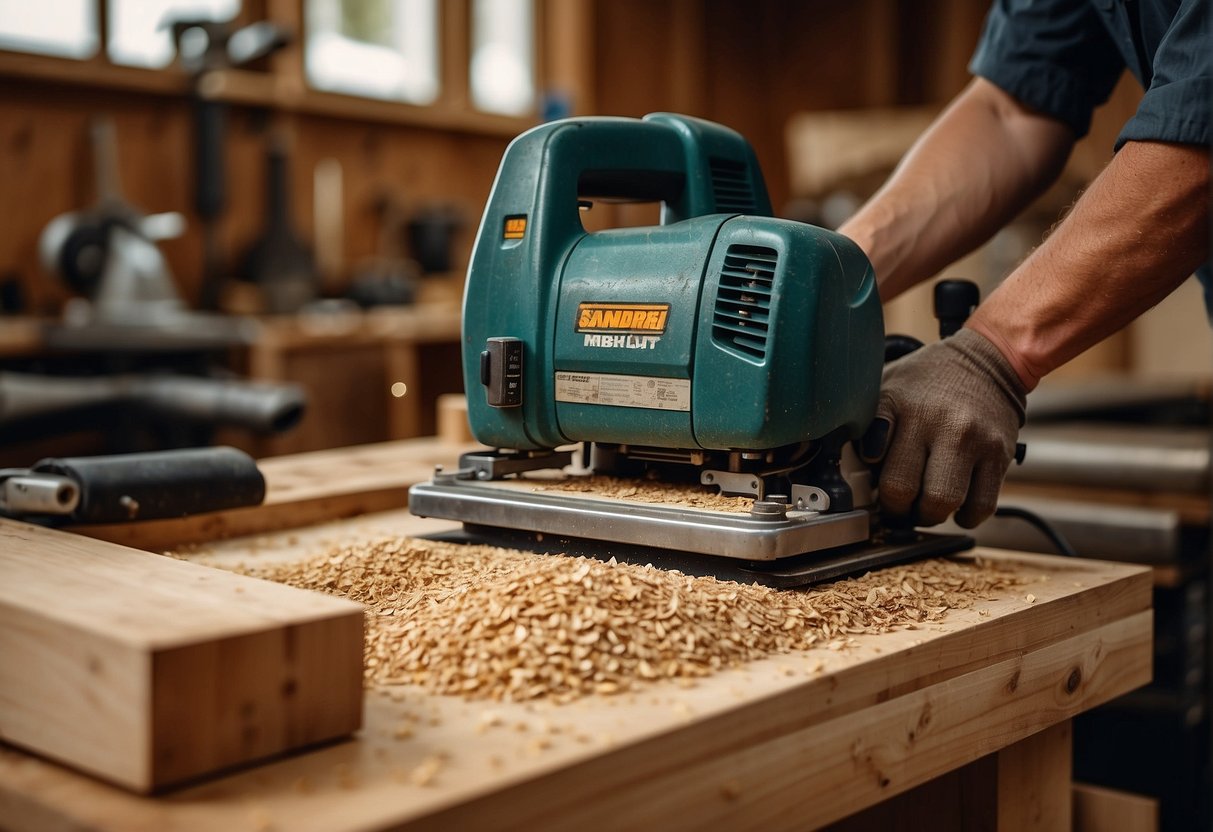When it comes to woodworking, there are a variety of tools that can be used to achieve different results. Two of the most commonly used tools are belt sanders and planers. While they may seem similar at first glance, they have distinct differences that make them better suited for certain applications. In this article, I will compare belt sanders and planers to help you choose the right tool for your woodworking needs.
Belt sanders are used to smooth wood and remove small amounts of material. They are typically smaller and more portable than planers, making them easier to move around the house. Planers, on the other hand, are used to remove larger amounts of material and create a flat surface. They are larger and less portable than belt sanders, but they are more accurate and produce a smoother finish. Understanding the differences between these two tools is essential to choosing the right one for your project.
In this article, I will discuss the functionalities of belt sanders and planers, compare their advantages and limitations, and provide tips for maintenance and safety. I will also answer some frequently asked questions to help you make an informed decision. By the end of this article, you will have a better understanding of the differences between belt sanders and planers and be able to choose the right tool for your woodworking needs.
Key Takeaways
- Belt sanders are best for minor projects like removing small amounts of wood or smoothing boards after they’ve been finished with a planer job, while planers are better suited for removing larger amounts of material and creating a flat surface.
- Both tools have unique advantages and limitations, making them more suitable for specific tasks.
- Proper maintenance and safety measures are crucial for both belt sanders and planers to ensure longevity and optimal performance.
Understanding Belt Sanders and Planers
As a woodworking enthusiast, I understand the importance of having the right tools for the job. Belt sanders and planers are two of the most essential tools in any woodworker’s arsenal. They are both designed to help you achieve a smooth and even surface on your woodwork, but they work in different ways. In this section, I will explain the fundamentals of belt sanders and the essentials of planers.
Fundamentals of Belt Sanders
A belt sander is a power tool that uses a sanding belt to remove material from wood surfaces. The sanding belt is a loop of abrasive paper that rotates around two drums, allowing you to sand large areas quickly and efficiently. Belt sanders are available in different sizes, ranging from small handheld models to large stationary models.
One of the advantages of a belt sander is that it can remove material quickly. This makes it ideal for rough sanding and shaping, as well as removing old paint or varnish from a surface. However, it can be difficult to achieve a smooth finish with a belt sander, particularly on delicate or intricate surfaces.
Essentials of Planers
A planer is a woodworking tool that is used to create a smooth, even surface on a piece of wood. It works by removing a thin layer of wood from the surface of the board using a set of rotating blades. Planers are available in different sizes, ranging from handheld models to large stationary models.
One of the advantages of a planer is that it can create a smooth and even surface quickly and efficiently. This makes it ideal for preparing wood for finishing, as well as for creating flat and straight edges. However, planers are not designed for removing large amounts of material quickly, and they can be difficult to use on rough or irregular surfaces.
In conclusion, belt sanders and planers are both essential woodworking tools that can help you achieve a smooth and even surface on your woodwork. While they work in different ways, they each have their own advantages and disadvantages. By understanding the fundamentals of belt sanders and the essentials of planers, you can choose the right tool for the job and achieve the best possible results.
Comparing Functionalities
When it comes to comparing the functionalities of belt sanders and planers, there are a few key factors to consider. In this section, I will be discussing two of the most important functionalities of these tools: Material Removal Efficiency and Surface Finishing and Uniformity.
Material Removal Efficiency
One of the primary functions of both belt sanders and planers is to remove material from a surface. However, they go about this in different ways. Belt sanders use a sanding belt to gradually wear away the surface of the material, while planers use a blade to shave off thin layers of wood.
In terms of material removal efficiency, planers are generally more efficient than belt sanders. This is because planers are able to remove a larger amount of material with each pass. However, belt sanders are better suited for removing material from irregular surfaces and hard-to-reach areas.
Surface Finishing and Uniformity
Another important factor to consider when comparing the functionalities of belt sanders and planers is surface finishing and uniformity. Belt sanders are better suited for creating a smooth, even surface on a material. This is because the sanding belt is able to conform to the shape of the material, resulting in a more uniform finish.
On the other hand, planers are better suited for creating a flat, even surface on a material. This is because the blade is able to shave off thin layers of wood, resulting in a more uniform thickness.
In conclusion, both belt sanders and planers have their own unique functionalities and are better suited for different tasks. When deciding which tool to use, it’s important to consider factors such as material removal efficiency and surface finishing and uniformity.
Applications in Woodworking
As a woodworker, I have found both belt sanders and planers to be essential tools in my workshop. Both tools have unique applications that make them indispensable for various woodworking projects.
Shaping and Leveling Wood
When it comes to shaping and leveling wood, a belt sander is the go-to tool for me. Belt sanders are perfect for removing large amounts of material quickly and efficiently. They are also great for shaping and smoothing out rough edges, making them ideal for projects that require a lot of sanding, such as furniture making.
On the other hand, planers are better suited for leveling wood surfaces. They are perfect for flattening and squaring up rough lumber, making them an essential tool for any woodworking project that requires a flat surface, such as tabletops or shelves.
Refinishing and Smoothing Surfaces
If you’re looking to refinish and smooth out surfaces, both belt sanders and planers can be used, depending on the project. Belt sanders are great for removing old finishes and smoothing out rough surfaces. They are also ideal for removing scratches and stains from wood surfaces.
Planers, on the other hand, are better suited for smoothing out rough surfaces and removing any remaining imperfections left by a belt sander. They are also great for creating a uniform thickness across a large piece of wood, making them ideal for projects that require consistent thickness, such as molding or trim work.
Overall, both belt sanders and planers have their unique applications in woodworking, and choosing the right tool for the job is essential for achieving the best results.
Advantages and Limitations
Belt Sander Pros and Cons
As a belt sander is designed to remove material quickly, it’s an ideal tool for heavy-duty sanding tasks. It can remove large quantities of material in a short amount of time, making it a time-efficient tool. One of the greatest benefits of a belt sander is its versatility. It can be used for a wide range of tasks, including sanding, shaping, and smoothing. It’s also a cost-effective tool, as it can replace multiple tools in your workshop.
However, a belt sander has some limitations. It’s not the most precise tool, so it’s not ideal for fine woodworking tasks. It can also be tricky to control, especially for beginners. Due to its power and speed, a belt sander can easily remove too much material, ruining your project. Additionally, belt sanders can be noisy and produce a lot of dust, so it’s important to wear proper protective gear.
Planer Strengths and Weaknesses
A planer is a precision tool that’s designed to create smooth, flat surfaces. It’s ideal for tasks such as removing rough saw marks and creating a consistent thickness throughout a board. One of the greatest benefits of a planer is its precision. It can create perfectly flat and parallel surfaces, making it an essential tool for fine woodworking.
However, a planer has some limitations. It’s not a versatile tool and can only be used for specific tasks. It’s also not a fast tool, as it removes material slowly and steadily. Additionally, planers can be expensive, so they may not be suitable for those on a tight budget.
In summary, both belt sanders and planers have their advantages and limitations. While belt sanders are versatile and time-efficient, they lack precision and can be difficult to control. Planers, on the other hand, are precise and essential for fine woodworking tasks, but they’re not versatile and can be expensive.
Maintenance and Safety
Caring for Your Tools
As with any power tool, proper maintenance is crucial for the longevity and performance of your belt sander or planer. Keeping your tools clean and well-oiled will not only extend their lifespan but also ensure that they operate at peak efficiency. After each use, wipe down the surfaces of your tool with a clean cloth to remove any dust or debris. For tougher grime, use a mild detergent and warm water, and make sure to dry the tool thoroughly before storing it away.
In addition to regular cleaning, it’s important to keep your tools well-lubricated. Apply a few drops of oil to the moving parts of your tool, such as the bearings and gears, to keep them running smoothly. Check your owner’s manual for specific lubrication instructions, as different models may require different types of oil.
Operating with Caution
When using a belt sander or planer, safety should always be a top priority. Before starting your tool, make sure to read the owner’s manual thoroughly and familiarize yourself with all of the safety features and precautions. Always wear eye and ear protection, as well as a dust mask to protect yourself from flying debris and harmful dust.
When operating your tool, keep your hands and fingers away from the moving parts, and never attempt to remove material that is too thick or hard for your tool to handle. Always use a push stick or other safety device to guide your workpiece through the tool, and never force the material through the tool.
In addition to these precautions, it’s important to keep your work area clean and free of clutter. This will not only reduce the risk of accidents but also make it easier to operate your tool safely and efficiently.
Overall, by following these simple maintenance and safety tips, you can ensure that your belt sander or planer remains in top condition and operates safely and effectively for years to come.
Frequently Asked Questions
What are the primary differences between a belt sander and a planer in woodworking?
Both belt sanders and planers are used for removing material from wood surfaces, but they differ in their approach. A belt sander uses sandpaper to smooth and shape wood, while a planer uses a rotating blade to remove thin layers of wood to create a flat surface. Belt sanders are better suited for shaping and smoothing curved surfaces, while planers are better suited for flattening large, rough surfaces.
Can a belt sander effectively replace a planer for flattening wood surfaces?
While a belt sander can be used to flatten wood surfaces, it is not as effective as a planer. Planers are specifically designed to remove thin layers of wood and create a flat surface, making them better suited for this task. Belt sanders are better suited for shaping and smoothing curved surfaces.
What are the advantages of using a planer over a belt sander?
The main advantage of using a planer over a belt sander is that it can remove large amounts of material quickly and efficiently to create a flat surface. Planers are also better suited for creating precise thicknesses and parallel surfaces. Additionally, planers are less likely to leave behind sanding marks or scratches on the wood surface.
In what scenarios is a belt sander preferred over a planer?
Belt sanders are preferred over planers when working with curved or irregularly shaped surfaces, as they are better suited for shaping and smoothing these types of surfaces. They are also useful for removing small amounts of material and for sanding between coats of finish.
How do the results of planing compare to sanding when preparing wood for finishing?
Planing and sanding both prepare wood surfaces for finishing, but they differ in their approach. Planing creates a smooth, flat surface by removing thin layers of wood, while sanding smooths and shapes the surface by removing small amounts of material. Planing is generally faster and more efficient than sanding for creating a flat surface, but sanding can be used to create a smoother, more polished surface.
What specific tasks in woodworking would require a planer instead of a belt sander?
Tasks that require a planer instead of a belt sander include flattening large, rough surfaces, creating precise thicknesses and parallel surfaces, and preparing wood for joinery. Planers are also useful for creating uniform stock for furniture making and for removing saw marks from rough lumber.

Hi, I’m Sal Muller of Tooltrip.com. My DIY experience led me to understand essential power tools for home projects. Tooltrip.com guides enthusiasts and professionals in choosing right tools for any job. I provide concise top tool reviews for easier, efficient DIY.





